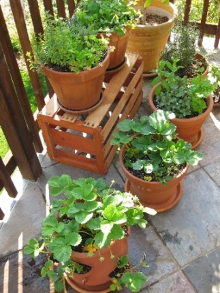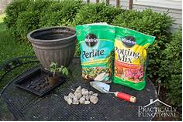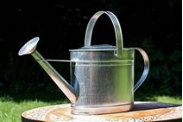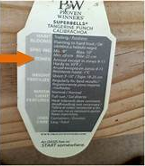Written by UConn Dietetic Intern Aylin Kavgaci
 Growing your own food can be both joyful and rewarding. If you’re looking for a way to easily grow vegetables but don’t have a ton of space or gardening experience, setting up a patio vegetable garden in pots may be perfect for you! You can grow just about any vegetable in a pot, and the joy of harvesting and eating your own vegetables is like no other.
Growing your own food can be both joyful and rewarding. If you’re looking for a way to easily grow vegetables but don’t have a ton of space or gardening experience, setting up a patio vegetable garden in pots may be perfect for you! You can grow just about any vegetable in a pot, and the joy of harvesting and eating your own vegetables is like no other.
For those of you who are trying to eat healthy on a budget, this can save you some money during the growing season in CT. Some easy veggies you can grow in pots include cucumbers, tomatoes, peppers, eggplant, and herbs such as basil, mint, thyme, parsley, rosemary, dill, and lemongrass1. Sounds enticing, right?
So, how can you get started? Vegetable container gardening can be both practical and enjoyable, however that doesn’t mean that a few problems won’t crop up.
Here are 10 key tips to get your patio/pot gardening off to a good start and a good growing season:
1. Choose the Right Container: Generally, choosing a container that is as large as possible is best. This is because small containers dry out more quickly and will need nearly daily watering2. A deeper pot holds more soil, hence will dry out less quickly. Either clay or plastic material will work but note that clay pots are porous and potting soil will dry out more quickly, requiring more frequent watering2.Plastic pots hold onto more water which could be an issue for some plants, but would be the ideal choice for plants that thrive in moist soil, or for those gardeners who forget to water!
2. Don’t Forget Your Roots: Some plants have deep roots that need larger and deeper containers! Examples of plants with deep roots (8-9”) include: carrots; cucumber; eggplant; leeks; peppers; spinach; parsley; and rosemary. Those with really deep roots (10-12″) are beets; broccoli; potatoes; summer squash; dill; and lemongrass1.
3. Every Plant is Different: Remember that every vegetable and herb is different, each with their own specific needs!
- Tomatoes: Tomatoes need a support system to keep them upright. Using a wooden stake (gently tie limbs of plants to the stake) or a tomato cage can help. Peas would also benefit from tall supports in their container3.
- Carrots: Carrots need a lot of room to grow, so make sure to use a container that’s double the depth that the variety states that it needs3. Unlike carrots, radishes don’t need a large container!
- Leafy greens: Spinach and leaf lettuce are some greens that you can snip and harvest every couple of days. They also grow best in the spring or fall and can tolerate partial shade, making them perfect options if you don’t have too much sunlight!
- Zucchini squash & Cucumbers: For these vegetables, buy the bush versus the sprawling vine varieties. They also grow full, large, and very fast; one plant can fill a 24-inch pot3! These would also benefit from supports as well.
- Potatoes: Depending on the variety, some potatoes have a 120-day growing season, so when buying look for the types that mature early3.
- Eggplant: Many varieties are sensitive to temperatures cooler than 50 degrees F3.
4. Select a Sunny Spot: As a general guideline, most veggies need at least six to eight hours of daily sunlight1. Veggies such as tomatoes, peppers, and beans love sunlight and will take as much as they can! Greens and herbs however may be fine with less sun. Another thing to consider is wind. Make sure your plants are not placed in the open and exposed to a lot of wind1. A tip for wind protection is to place your larger plants in front of your smaller ones facing the way winds typically blow where you live!
5.  Soil is Important: Using regular garden soil is not the way to go for veggies in pots! This is because garden soil does not drain well2. The best option is to use a planting “mix” made for potted plants or planters; this will ensure moisture retention and good drainage3. Buying a typical “potting soil” would also work!
Soil is Important: Using regular garden soil is not the way to go for veggies in pots! This is because garden soil does not drain well2. The best option is to use a planting “mix” made for potted plants or planters; this will ensure moisture retention and good drainage3. Buying a typical “potting soil” would also work!
6. Fertilize Your Plants: A key tip for growing veggies in pots is regular fertilization. Most potting soils do not come with any nutrients; therefore, you need to provide fertilizer for your plants to thrive and produce food4. Mixing a good amount of granular fertilizer (easily found at your local gardening shop!) into the potting soil is a good way to start2. Then as your veggies grow, begin to use liquid fertilizer regularly1.
7.  Proper Watering is Key: Veggies need the right amount of water to be their best selves! Not enough water can cause issues like poor root development, leaf curling, rot, and encourage insects to visit1! If you struggle with watering, a great idea may be to use a self-watering planter. This way the plants only take as much water as they need, and you only have to fill the reservoir every couple of days3.
Proper Watering is Key: Veggies need the right amount of water to be their best selves! Not enough water can cause issues like poor root development, leaf curling, rot, and encourage insects to visit1! If you struggle with watering, a great idea may be to use a self-watering planter. This way the plants only take as much water as they need, and you only have to fill the reservoir every couple of days3.
8. Combine Your Pots: Combining multiple plants into one pot can be a good way to save space and create a beautiful visual assortment! Something to consider though is whether the plants are compatible. Some examples of good companions: tomatoes, basil, and onions together, and lettuce and herbs together1. Some poor combinations are carrots with dill, and tomatoes with potatoes1!
9.  Keep the Plant Tags: The tags the plants come with are crucial! Make sure to read the tags as they contain important information, such as how tall your plant will grow, and how much water, light, and care it will need4. The tag also provides useful tips about the shape the growing and mature plant will take (straight, tall, mound-like, etc.), which is essential to know when choosing the right container or plant combinations4
Keep the Plant Tags: The tags the plants come with are crucial! Make sure to read the tags as they contain important information, such as how tall your plant will grow, and how much water, light, and care it will need4. The tag also provides useful tips about the shape the growing and mature plant will take (straight, tall, mound-like, etc.), which is essential to know when choosing the right container or plant combinations4
10. Don’t Worry, Plants Die: It is ok if your plants die! In gardening, it is simply a natural occurrence; it happens. There are some tips you can try to revive them. One option you can try is to cut the plant back significantly, leaving the roots, then see how it goes from there4.This will work most of the time, given a couple weeks. You can also try repotting, as this may help to restore it as well4.
Citations:
- https://www.gardeners.com/how-to/urban-gardening-with-vegetables/5491.html
- https://www.gardeners.com/how-to/patio-vegetable-garden/8576.html
- https://www.thespruce.com/vegetable-container-gardening-for-beginners-848161
- https://www.thespruce.com/ten-container-garden-tips-for-beginners-847854
This material is funded by UDSA’s Supplemental Nutrition Assistance Program (SNAP).
This institution is an equal opportunity employer.